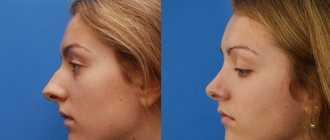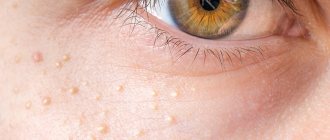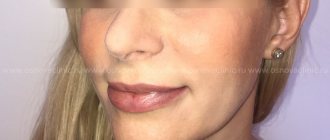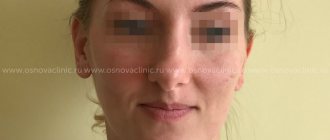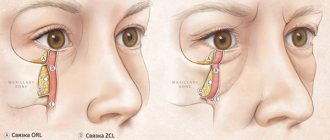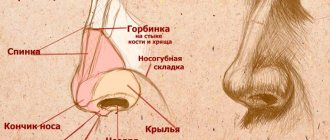If after rhinoplasty a callus has formed on the bridge of the nose, it means that compensatory mechanisms have not worked in favor of the patient.
This growth is the body’s desire to create a safety margin after surgery. It is because of this that excess bone fibers grow in the operated area. Their accumulation is called “callus”. This phenomenon is quite rare, but every person who has undergone rhinoplasty is at risk. According to statistics, 12% of patients are susceptible to this complication, and in 30% of these cases reoperation is needed. Callus after rhinoplasty is not life-threatening, but it needs to be removed, as it can cause chronic pain and other complications, which we will discuss later.
It takes about a year for such a defect to form. This is the result of the standard process of tissue regeneration after correction, if bone was affected during it. If the surgeon did not manipulate the bone frame, then a callus will not appear. The structure of such a defect is connective tissue that grows at the junction of bones. The growth process takes place in three stages:
- a provisional callus is formed;
- osteoid tissue appears;
- connective tissue fibers appear instead of bone fibers.
Sometimes cartilage forms first and then bone is formed from it.
To prevent such a defect from appearing, after rhinoplasty you need to strictly follow the surgeon’s recommendations. At the same time, young people aged 17-18 years are more susceptible to hypercalluses, because in this period the germinal area is most active and the regeneration processes are more intense. Therefore, it is recommended to do rhinoplasty when the development of cartilage and bones is completed, that is, after 25 years.
In order to promptly identify the defect and “catch” it in the initial stages of formation, after the operation you need to regularly visit a plastic surgeon at the clinic where the rhinoplasty was performed. The consultation schedule is as follows: after 1, 2, 3, 6 months and after 1 year. If the doctor notices that a callus has begun to form, he will prescribe treatment in a timely manner.
You cannot massage the callus on the bridge of the nose after rhinoplasty on your own or try to remove it in other ways, because it can only make it worse.
Types of calluses
- Periosteal (external) – formed from the outside, from the side of the periosteum. During its formation, osteogenic cells actively divide, turning into osteoblasts, that is, the main “building elements” of bone.
- Endosteal (internal) - formed on the endosteum side from osteogenic cells that turn into osteoblasts and produce substances that are necessary for the formation of the intercellular matrix.
- Intermediate (intermediate) - formed between external and internal. It is this formation that connects fragments of dissected or otherwise damaged bone.
Do calluses go away after rhinoplasty?
External and internal calluses form first. They temporarily immobilize the debris and create optimal conditions for their subsequent fusion. Gradually they dissolve, and in their place periosteum and bone tissue appear. The intermediary formation is formed later, but it is this formation that consolidates the bone fragments.
Symptoms
Signs of a fracture and secondary fusion with the formation of periosteal callus are:
- local pain that subsides;
- crepitus – a characteristic crunching sound, especially when trying to move a limb;
- disappearance of pathological mobility;
- distortion of the shape and structure of the bone during the formation of a paraosseous callus, which may look like a large protrusion.
Callus after a clavicle fracture
After a clavicle fracture, a natural process of formation, first of osteodin, then of callus, also occurs, which usually takes up to 2 months. The causes of fractures are most often falls, sports injuries, road accidents, and are also possible in newborns during birth.
Callus after a clavicle fracture
After the collarbone has completely fused, the callus should resolve, but in some cases this does not happen, as in the photo of the callus presented above.
Causes
The frame of the nose is made up of bones and cartilage. During rhinoplasty, certain elements are removed, and therefore such an operation is always associated with damage to the internal nasal structures. And a common reaction to this occurs in the form of activation of the body’s defense mechanisms. At the same time, bone tissue, unlike others, heals in a special way. A growth always forms if bone is touched during rhinoplasty. Its size depends on the degree of tissue injury and the individual characteristics of the body, including the intensity of regeneration processes.
The main causes of the defect:
- individual response to damage related to the degree of bone restoration;
- little experience and low qualifications of a plastic surgeon.
Features of treatment
The goal of treatment is to eliminate the possible complication. For this, various techniques and methods are used. It is important to use them immediately after surgery. This approach makes it possible to get the desired result faster.
But if there are individual contraindications, effective procedures may be limited. At the first stage, the most important thing is to reduce inflammation at the site of injury using medications.
The tumor can also be removed through surgery. Surgical intervention is a last resort; it is used when other methods have not brought the desired result.
Often this defect after taking medications can manifest itself as the following unpleasant sensations:
- Increase in temperature;
- The appearance of severe pain and redness of the bridge of the nose;
- Difficulty breathing.
Recommendations from specialists are always aimed at effective and safe restoration of damaged tissue. Failure to comply with these rules can lead to serious complications for the patient. Regular visits to the surgeon will help you avoid such complications and undergo rehabilitation faster.
It is important to remember that the body's natural defense system can cause some problems as a result of rhinoplasty. But timely use of physical therapy and medications prevents the need for repeat surgery. As a result of a set of procedures and taking certain medications, the callus quickly resolves.
Taking good care of your body always allows you to maintain a beautiful appearance of your face and the functionality of your nose.
Diagnostic and treatment methods
The defect can be seen after an x-ray. On photographs it will appear as a membrane in the area of bone damage.
The rehabilitation process is long and the main goal of therapy is to stop excessive tissue growth. Some procedures that should be started immediately after surgery can help cope with this defect. First of all, you need to take anti-inflammatory drugs prescribed by your doctor. They will also help enhance tissue nutrition. In addition, physical therapy and repeat surgery are prescribed.
Drug treatment
The patient must take decongestants, which at the same time help nourish the tissues. Most often these are glucocorticosteroids. The doctor may prescribe strengthening medications, painkillers that promote scarring, etc.
Excessive tissue growth can cause infection, so you need to take antibiotics prescribed by your doctor, without interrupting or stopping the course ahead of time.
Physiotherapy
Physiotherapeutic treatment is very long, but it is one of the most effective. All procedures must be done under the supervision of a doctor.
In the process of physiotherapy, resorption of the defect improves and regenerative processes are accelerated.
Most often, magnetic therapy, UHF, electrophoresis with certain drugs, phonophoresis with medications, and thermotherapy are prescribed. If the patient has a persistently elevated body temperature, then most techniques are prohibited. There are other contraindications. Therefore, before undergoing physical therapy, consultation with a doctor is mandatory.
Repeated operation
It is prescribed rarely and against the background of ineffectiveness of other treatment methods. Other indications for surgery are redness, swelling, and periodic increases in body temperature. All these symptoms should be associated with the growth. However, the operation does not guarantee that there will be no relapse, so you need to strictly follow all recommendations and ensure proper prevention of recurrence of the defect.
Callus: causes, symptoms, treatment
What kind of sore is a callus?
Bone callus is different from skin callus. More precisely, there is not even anything in common between them. It can occur as a consequence of a fracture if the bones have not healed properly. It happens that bumps on the legs appear after fractures, and this may turn out to be a callus.
There is nothing so terrible about this sore. It occurs before the bone is about to heal. Again, there is nothing terrible only if you start treatment when it is at the initial stage. Otherwise, there will be serious complications, including the inability to move the diseased bone.
When a bone is injured, severe hemorrhage occurs in the soft tissues. As a result, extensive swelling of the limbs develops. Swelling may cause blisters filled with blood to appear. After a few days, when the swelling begins to decrease and the bloody blisters disappear, the bone fragments begin to grow together. At this moment, a bone callus appears.
Types of Callus
There are four types of callus:
- Periosteal type - the callus occurs on the outside of the broken bone. It can heal quickly as there is an excellent blood supply.
- Another type is intermedial callus. It can appear between pieces of broken bones. A space is formed between them, which is filled with a network of vessels. This process also affects the fact that the callus may soon disappear.
- Endosteal type - a similar callus appears in the bone marrow cells.
- The last type is paraosseous callus. This is the worst type, because with it the healing of the broken bone is very slow. The callus appears from the soft tissue located next to the fracture.
How to deal with callus?
As mentioned above, callus should be treated as soon as it appears, otherwise the healing process may take a long time. How to cure it?
Usually the callus is always removed. This is possible with the help of surgery. Although doctors do not always agree to perform such an operation, because complications may arise during the procedure, because there is a possibility of bone damage.
You can also resort to physical therapy using magnetotherapy or electrophoresis. Doctors believe that these procedures are very effective in combating this disease. The healing process of broken bones is accelerated thanks to this method. The main thing is that when getting rid of calluses, there is no physical activity, and also overheating or, conversely, hypothermia should be excluded.
Broken bones take a different amount of time to heal for each person. This is influenced by the type of injury, as well as what caused the fracture. So, with a gunshot wound, regeneration takes much longer.
How to diagnose the disease?
Callus formation can be detected by taking an x-ray. Since the formation does not occur immediately, but gradually, all x-rays should be saved to monitor the process. Callus, after all, is formed in order to restore the integrity of the bone.
Treatment is provided by specific trauma doctors. They will immediately diagnose you and determine when the bone was injured - recently or a lot of time has passed. The presence of a callus proves that the person was injured a long time ago.
Prevention of callus formation
As you already understand, treating a callus requires a significant amount of time. Therefore, it is better to prevent the disease than to treat it.
Even if you have a simple bruise and, especially, cracks, even small ones, be sure to contact a specialist.
Do whatever your doctor tells you to do, especially if they tell you to put on a splint or cast. Be sure to fix the sore spot.
Be sure to start correcting pathologies that have arisen during bone fusion.
If the fracture is open, then antibacterial prophylaxis should be carried out.
Author: K.M.N., Academician of the Russian Academy of Medical Sciences M.A. Bobyr
Prevention: how to avoid the appearance of a growth after plastic surgery?
In the postoperative period, it is necessary to create optimal conditions for the formation of normal callus. To do this, you must follow all the instructions given by the surgeon:
- do not blow your nose for two weeks;
- sneeze with your mouth open;
- do not wear glasses and exclude any other mechanical impacts and damage to the operated area;
- monitor the correct position of the plaster splint, do not displace it or remove it prematurely;
- do not start playing sports until your doctor allows it;
- at the first symptoms of bone hypergrowth, consult a doctor;
- immediately after plastic surgery, observe bed rest for three days;
- Do not stay in the sun for a long time and do not go to the solarium.
Types of fractures
Like any other, a nasal fracture can be open or closed. An open fracture is accompanied by a violation of the integrity of the skin, that is, an open laceration forms at the site of injury. It happens that the patient even sees bone fragments through it.
In the case of a closed fracture, a violation of the integrity of the bone is not accompanied by a violation of the integrity of the skin over the fracture area. But with such damage, hematomas and bruises may occur.
Both injuries can be accompanied by displacement—visible deformation of the nasal wall.
In both cases, you should immediately seek medical help. If in the second case the patient can go to the doctor on his own, then with an open injury the person cannot move, so it is necessary to call an ambulance.
Preparing for surgery
The reduction is carried out by an otorhinolaryngologist. Before starting the operation, the ENT doctor makes preoperative preparations. The ENT doctor recommends that the patient take an anesthetic and treats the surgical field with an alcohol antiseptic.
Then the ENT doctor performs anesthesia - injecting painkillers into the nasal cavity. As a rule, the operation is performed under local anesthesia. General anesthesia is used for a fractured nasal septum or if more than ten days have passed since the injury. The operation itself is carried out using special instruments - Volkov elevators. The elevator is inserted into the nasal passage, and the ENT doctor uses his fingers to realign the displaced bone, returning it to its original position.
Rehabilitation.
To speed up the recovery of slowly healing fractures, the following is prescribed:
- Physiotherapy (iontophoresis of calcium salts, UHF, anabolic hormones, quartz irradiation, etc.)
- Physical therapy
- Mud therapy
- Taking calcium supplements in combination with zinc, folic acid, magnesium, vitamins D, C, B.
- Proper nutrition with the obligatory inclusion in the diet of cottage cheese, dairy products, hard cheeses, cod, salmon, beans, liver, and cereals
The treatment process must not be disrupted, as complications may arise. Slowly consolidating bone injuries can lead to additional surgery and a new course of rehabilitation.
General recommendations
If you decide to have your nose corrected, you will need to make some efforts to reduce the risk of negative consequences after surgery.
Plastic surgeons advise the following:
- For the first few days after surgery, you should avoid any physical activity and try to rest as much as possible.
- You should refrain from blowing your nose for two weeks.
- In the first month, avoid visiting bathhouses, saunas, solariums and other places where exposure is associated with elevated ambient temperatures.
- If you play sports, then take a break for two months.
- During the rehabilitation period, wearing glasses is contraindicated so as not to create a load on the bridge of the nose.
- Avoid eating foods that are too cold or hot.
- Do not stay in direct sunlight for a long time.
These simple tips will reduce the likelihood of developing hyperplasia, but will not completely eliminate it, so you should monitor your health and, if any problems arise, you should immediately go to the hospital.
What are the risks of a broken nose?
Damage to the nose can lead to serious consequences for human health:
- nosebleeds;
- concussions of varying severity;
- damage to the nasolacrimal duct;
- impaired sense of smell, inability to distinguish odors (hyposmia and anosmia);
- frequent sinusitis and inflammation of other paranasal sinuses (frontitis, ethmoiditis, sphenoiditis);
- proliferation of the inferior turbinates (hypertrophic and vasomotor rhinitis), as a result, severe difficulty in nasal breathing;
- persistent ear congestion (eustacheitis, tubootitis, adhesive otitis media), which makes it difficult for a person to communicate normally with others;
- painful flow of mucus through the nasopharynx due to the involvement of the posterior ends of the inferior turbinates in the inflammatory process;
- deformation of the nasal septum, which can lead to disruption of normal breathing through the nose. Impaired breathing provokes frequent exacerbations of chronic rhinitis, the patient is more often exposed to viral attacks, and cases of acute respiratory viral infections are becoming more frequent;
- the appearance of an invisible hematoma of the nasal septum, which can lead to suppuration and melting of the nasal cartilage;
- blood poisoning through a wound. The paranasal sinuses are located near the fracture site. An inflammatory process can start in them, which can subsequently spread to the membranes of the brain;
- aesthetic effect - the displacement changes the appearance of the nose, distorting the person’s face.
First aid
Before arriving or visiting a doctor, the patient must be given first aid. To begin with, he needs to be seated so that his head is slightly tilted forward, so that blood from the nasal cavity will not flow into the respiratory tract. Blood clots must be removed very carefully from the area of injury. If cuts are visible, they should be treated with an antiseptic, for example, hydrogen peroxide, Chlorhexidine or Miramistin. Then apply cold to the site of the bruise - this will help reduce swelling and reduce the amount of bleeding.
Trying to set the bones yourself is strictly prohibited!!! It won't work for sure!!! You don't even have to try!!! Lack of necessary knowledge, as well as inept actions can lead to disruption of normal nasal breathing. Do not forget also that the reduction process is quite painful and is not carried out without anesthesia, so as not to cause traumatic shock in the patient. Among other things, you need special tools, good light, a comfortable position for the patient and adequate anesthesia!
Only a doctor should perform repositioning of the nasal bones!
